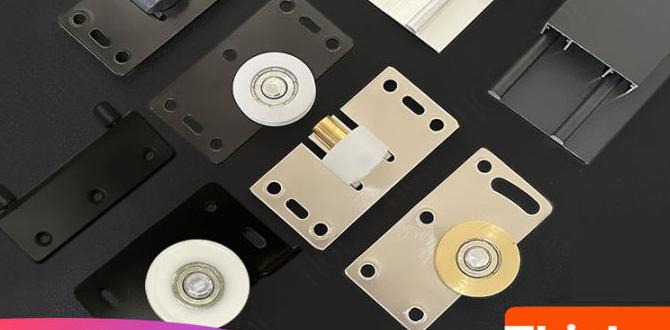Quick Summary
Proper nail gun storage and battery care are crucial for longevity and performance. This guide offers simple, actionable tips to keep your nail gun ready for any project and extend the life of its batteries, saving you time and money.
Hey there, DIYer! So, you’ve got a nail gun, ready to tackle that weekend project. That’s fantastic! But after the last nail is fired, what’s next? It’s easy to just toss it in the shed, but how you store your nail gun and care for its battery can truly make a difference. Neglecting these simple steps can lead to a tool that’s frustratingly unreliable or even unusable when you need it most. Don’t worry, though! This guide will walk you through everything you need to know, step-by-step, so your nail gun and its batteries stay in top shape. Let’s get your tools ready for their best performance and longest life!
Table of Contents
Why Nail Gun Storage and Battery Care Matter So Much
Think of your nail gun as a finely tuned instrument. Just like any power tool, it requires a little TLC to perform at its best. Proper storage isn’t just about keeping things tidy; it’s about protecting your tool from dust, moisture, extreme temperatures, and accidental damage. This helps prevent rust, corrosion, and mechanical issues that can be costly and time-consuming to fix.
And the batteries? They’re the heart of your cordless nailer! Lithium-ion batteries, which are common in modern cordless models, are sensitive to how they are treated. How you charge, store, and use them directly impacts their capacity, lifespan, and even safety. Following good battery care habits means you’ll get more uses out of each charge and avoid premature battery failure. You want your nail gun to be your trusty sidekick, not a problem child. By investing a little time in these practices, you ensure reliability, safety, and the best value for your tool investment.
Essential Nail Gun Storage Tips
Storing your nail gun properly is key to its longevity. It’s not complicated, but a few simple habits go a long way in protecting your investment.
1. Clean Your Nail Gun After Every Use
Before you even think about putting your nail gun away, give it a good once-over. Dust, debris, and wood shavings can accumulate in and around the tool. This gunk can clog mechanisms, damage seals, and even cause internal parts to wear down faster. A quick wipe-down is usually all that’s needed.
- Use a soft, dry cloth to wipe down the exterior of the nail gun.
- Pay attention to the magazine area where nails are fed. Remove any sawdust or wood chips.
- For stubborn debris, you can use a soft brush or compressed air (at a low setting) to gently clean crevices.
- Ensure no lubrication is removed unless specified by the manufacturer.
2. Empty the Nail Magazine
Leaving nails loaded in the magazine isn’t ideal. Firstly, it can create unnecessary pressure on the driving mechanism. Secondly, if the gun takes a knock, a loaded magazine increases the risk of a nail firing unexpectedly, which is a significant safety hazard. Always unload any remaining nails before storage.
- Open the magazine latch.
- Gently slide or tip the remaining nails out.
- Ensure the magazine is completely empty and free of any stray nails.
3. Protect Your Nail Gun from the Elements
This is one of the most critical storage steps. Your nail gun, especially its delicate internal mechanisms and electrical components, should be protected from moisture, extreme heat, and freezing cold.
- Moisture: Humidity can lead to rust and corrosion, particularly on metal parts. Never store your nail gun in a damp basement, uninsulated shed, or outdoors.
- Extreme Temperatures: Very high heat can warp plastic parts and damage battery cells (more on that later). Freezing temperatures can affect lubricants and potentially damage seals or internal components as moisture freezes.
- Direct Sunlight: Prolonged exposure to direct sunlight can degrade plastic components and overheat the tool and its battery.
4. Use the Original Case or a Dedicated Storage Solution
Most quality nail guns come with a sturdy carrying case. These cases are designed not only for protection during transport but also for effective storage. They often have custom-fit foam or compartments to keep the tool secure and prevent it from banging against other items.
- Manufacturer Cases: These are usually the best option. They are designed to fit your specific model and often include space for batteries and chargers.
- Tool Boxes: If you don’t have the original case or need to store multiple tools, a dedicated tool box provides good protection. Ensure the nail gun is secure and won’t shift around.
- DIY Storage: For a more permanent setup, consider custom shelving or wall mounts in a dry, temperature-controlled environment. Foam inserts can be cut to cradle the nail gun securely.
5. Store in a Dry, Climate-Controlled Environment
The ideal storage location is a place with a stable temperature and low humidity. This could be a workbench drawer, a closet in your home, a climate-controlled garage workshop, or a dedicated tool cabinet. Avoid storing your nail gun in places where temperature and humidity fluctuate wildly.
For instance, a standard garage or shed that gets very hot in summer and very cold in winter is not ideal for long-term storage, especially for the battery. If you must use such a location, try to keep the tool and battery in an insulated container or bring them indoors during extreme weather.
6. Secure the Trigger
To prevent accidental firing during handling or storage, always ensure the trigger mechanism is disengaged and, if your model has a safety lock, use it. Some nail guns have a safety lock-out switch or a mechanism that prevents the trigger from being pulled when the safety tip isn’t depressed. Familiarize yourself with your specific model’s safety features.
7. Keep Away from Liquids and Chemicals
Store your nail gun away from solvents, oils, or lubricants that are not specifically recommended by the manufacturer. These can damage plastic parts or seals. If you use lubricants for maintenance, ensure they are appropriate for your tool and only apply them as directed.
Battery Care Tips for Cordless Nail Guns
For cordless nail gun owners, battery care is just as important as tool storage. These are often the most expensive part of a cordless tool and taking care of them ensures you get the most out of your investment.
Understanding Your Battery (Lithium-Ion)
Most modern cordless nail guns use Lithium-Ion (Li-ion) batteries. They are popular because they offer good power, are relatively lightweight, and don’t suffer from the “memory effect” that older battery types did. However, Li-ion batteries have specific needs.
Key factors affecting Li-ion battery life include:
- Depth of Discharge: How much power is used before recharging.
- Charge Level: Storing batteries at certain charge levels can impact longevity.
- Temperature: Both charging and storage temperatures are critical.
- Physical Damage: Dropping or puncturing a battery can be dangerous and render it useless.
1. Charge Batteries Appropriately
Follow the manufacturer’s recommendations for charging. Most modern Li-ion chargers are intelligent and will stop charging when the battery is full, preventing overcharging. However, some general tips apply:
- Use the Correct Charger: Always use the charger supplied with your nail gun or an official replacement. Using an incorrect charger can damage the battery or pose a fire risk.
- Avoid Fully Depleting: While Li-ion batteries don’t have a memory effect, consistently draining them completely can stress the cells. It’s generally better to recharge when you notice a significant drop in power, rather than waiting until it’s completely dead.
- Don’t Leave on Charger Indefinitely: While smart chargers prevent overcharging, leaving a fully charged battery on the charger for extended periods (weeks or months) can sometimes lead to slight degradation. It’s best practice to remove the battery once it’s fully charged if you don’t plan to use it immediately.
2. Store Batteries Correctly
Proper battery storage is crucial, especially if you have spare packs or won’t be using your nail gun for a while.
- Temperature is Key: Store batteries in a cool, dry place. The ideal temperature range is typically between 40°F and 70°F (4°C and 21°C). Avoid storing them in areas that get too hot (like direct sunlight or a hot car) or too cold (freezing temperatures). Extreme temperatures can significantly degrade battery performance and lifespan.
- Charge Level for Storage: If storing for an extended period (over a month), it’s often recommended to store Li-ion batteries at around a 50-70% charge level. Storing them fully charged or completely depleted for long durations can stress the cells. Many manufacturers provide guidance on this. If unsure, check your tool’s manual.
- Keep Them Clean: Ensure battery terminals are clean and free of dirt or debris. This ensures good electrical contact when charging and using. A dry cloth or cotton swab can usually clean connections.
- Store in a Protective Case: If your battery came with a protective cover, use it. This prevents accidental short circuits if the terminals come into contact with metal objects.
3. Avoid Physical Damage
Lithium-ion batteries contain sensitive internal components and chemicals. Dropping a battery, puncturing it, or crushing it can lead to serious internal damage and, in rare cases, thermal runaway (overheating and potential fire). Always handle batteries with care.
- Never attempt to disassemble a battery pack.
- If a battery looks damaged, swollen, or is leaking, stop using it immediately and dispose of it properly.
4. Monitor Battery Health
Over time, all batteries will lose capacity. However, you can monitor your battery’s performance. If you notice a drastic or sudden decrease in run time, it might be a sign that the battery is nearing the end of its life or has been damaged.
Some higher-end tool systems have battery indicator lights, or the tool itself may have a diagnostic system. Pay attention to any warning signs.
5. Proper Disposal of Old Batteries
When a battery finally dies and can no longer hold a charge, it’s important to dispose of it correctly and safely. Li-ion batteries contain materials that can be harmful to the environment if not disposed of properly. They can also pose a fire risk if short-circuited.
Many local recycling centers, electronics stores, or hardware stores have battery recycling programs. Check with your local hazardous waste disposal authority or search online for battery recycling locations in your area. Do not throw them in your regular household trash.
Nail Gun Maintenance: A Quick Checklist
Beyond storage, a little regular maintenance keeps your nail gun running smoothly. This isn’t about deep mechanical work, but simple checks:
- Lubrication: For pneumatic nailers, ensure you are using the correct type and amount of oil as per the manual. For cordless and electric models, check if lubrication is required for specific parts. Over-lubricating can be as bad as under-lubricating.
- Check O-rings and Seals: Over time, rubber O-rings and seals can dry out or crack, leading to air leaks in pneumatic tools. Visually inspect them and replace if they look worn.
- Keep the Nose Clear: Ensure no nails or debris are stuck in the nose of the nail gun. This area is critical for safe and effective nail firing.
- Check Air Filter (Pneumatic): If you use a compressor, regularly check and clean the air filter to ensure clean air is going into your tool.
When to Seek Professional Help
While these tips cover most common scenarios, sometimes a nail gun needs more than just good storage and battery care. If you encounter persistent issues like:
- Frequent misfires or jams that cleaning doesn’t fix.
- Loss of power despite a fully charged battery or adequate air supply.
- Strange noises or vibrations during operation.
- Visible damage to internal components.
It’s best to consult your tool’s manual for troubleshooting or contact the manufacturer’s service center. Trying to force a repair without the right knowledge can cause further damage and void your warranty. Tools like the Occupational Safety and Health Administration (OSHA) provides guidelines on safe tool operation, and adhering to them indirectly helps maintain your tool’s condition.
Table: Nail Gun Storage Best Practices at a Glance
Here’s a quick reference to keep your nail gun in top condition:
| Storage Aspect | Best Practice | Why It Matters |
|---|---|---|
| Cleanliness | Wipe down after each use, remove debris from magazine. | Prevents rust, jams, and wear of internal parts. |
| Protection | Use original case or secure storage. | Guards against dust, moisture, impact, and accidental firing. |
| Environment | Store in a dry, climate-controlled environment (40-70°F). | Prevents damage from extreme temperatures and humidity. |
| Load Status | Always unload nails before storing. | Enhances safety and prevents undue stress on the tool. |
| Trigger Lock | Engage safety lock if available. | Prevents accidental firing. |
Table: Cordless Nail Gun Battery Care Summary
Keep your power source in prime condition:
| Battery Care Aspect | Best Practice | Impact on Battery Life |
|---|---|---|
| Charging | Use correct charger, avoid constant deep discharge. | Maximizes charge cycles, prevents cell stress. |
| Storage Temperature | Store between 40-70°F (4-21°C). | Prevents rapid degradation due to heat or cold. |
| Storage Charge Level | Around 50-70% for long-term storage. | Reduces long-term stress on Li-ion cells. |
| Physical Handling | Handle with care, avoid drops and punctures. | Prevents internal damage and safety hazards. |
| Cleaning | Keep terminals clean. | Ensures optimal energy transfer and charging efficiency. |
| Disposal | Recycle through proper channels. | Protects the environment and prevents fire risks. |
Frequently Asked Questions (FAQ)
Q1: Can I store my nail gun in my car for a few days?
A1: It’s generally not recommended, especially during extreme weather. Cars can get very hot in summer and very cold in winter, which can degrade your tool’s components and significantly shorten battery life. If you must, use an insulated container and bring batteries indoors.
Q2: How often should I clean my nail gun?
A2: For best results, clean your nail gun after every use. This includes wiping down the exterior and clearing any debris from the magazine and nose area. If you use it heavily or in dusty environments, a more thorough check might be needed more often.
Q3: My cordless nail gun battery doesn’t seem to last as long as it used to. What should I do?
A3: This is normal as batteries age. However, if the decrease is sudden or significant, check if the battery has been exposed to extreme temperatures or physical damage. Ensure you are charging it correctly and not consistently draining it completely. If the problem persists, the battery might be at the end of its lifespan and may need replacement. You can often check the health of your battery through your tool manufacturer’s app or diagnostic tools if available.
Q4: Do I need to lubricate my cordless nail gun?
A4: Most cordless nail guns do not require regular lubrication like pneumatic (air-powered) models do. However, always refer to your specific tool’s owner’s manual. Some models might have specific lubrication points or recommend periodic checks of seals rather than oiling.
Q5: Is it okay to store my nail gun with the battery attached?
A5: For short periods (a few days to a week), it’s usually fine. However, for extended storage (more than a couple of weeks), it’s often better to detach the battery. This prevents any




